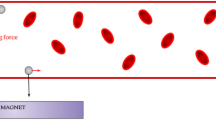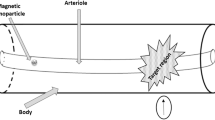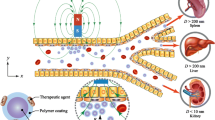Abstract
The concept of using magnetic nanowires (NWs) as carriers in magnetic drug targeting was largely developed in the last decade. Magnetically controlled and manipulated nanoparticles are gaining more and more ground in various biomedical applications: drug delivery, cancer therapy by magnetic fluid hyperthermia, radiotherapy. In this study, a 2-D mathematical model was developed and implemented to examine the capture of magnetic drug carrier particles within a magnetic trap represented by high magnetic field gradients. The transient dynamics of magnetic NWs under the effect of the blood velocity (v B) varied from 0.05 up to 1.0 cm/s, magnetic field strength and their initial position within the fluid channel have been analyzed using COMSOL Multiphysics module. The parameters related to the NW with strong influence on the magnetic trap output were systematically modified: magnetic material, cylindrical particle geometry characterized by diameter and length, its initial position related to both fluid flow direction and distance from the channel center. Considering the influence of both hydrodynamic, magnetic forces and torques the magnetic trap’s efficiency was evaluated and phase diagrams were determined for different parameters involved. A considerable number of simulations were made to obtain statistically significant results. These results are commented and discussed in detail.










Similar content being viewed by others
References
Augusto PA, Castelo-Grande T, Augusto P, Barbosa D, Estévez AM (2007) Supporting theory of a new magnetic separator and classifier. Equations and modeling. Part II. Magnetic particles. Curr Appl Phys 7:247–257
Avilés MO, Ebner AD, Chen H, Rosengart AJ, Kaminski MD, Ritter JA (2005) Theoretical analysis of a transdermal ferromagnetic implant for retention of magnetic drug carrier particles. J Magn Magn Mater 293:605–615
Bucak S, Jones DA, Laibinis PE, Hatton TA (2003) Protein separations using colloidal magnetic nanoparticles. Biotechnol Prog 19:477–484
Cao J, Wang Y, Yu J, Xia J, Zhang C, Yin D, Häfeli UO (2004) Preparation and radiolabeling of surface-modified magnetic nanoparticles with rhenium-188 for magnetic targeted radiotherapy. J Magn Magn Mater 277:165–174
Carroll S, Al-Rubeai M (2005) ACSD labelling and magnetic cell separation: a rapid method of separating antibody secreting cells from non-secreting cells. J Immunol Methods 296:171–178
Clime L, Veres T (2008) Magnetically controlled dielectrophoresis of metallic colloids. J Colloid Interface Sci 326:511–516
Davison SM, Sharp KV (2006a) Implementation of ALE moving mesh for transient modeling of nanowire trajectories caused by electrokinetic force. In: Proceedings of the COMSOL Multiphysics Users’ Conference, Boston
Davison SM, Sharp KV (2006b) Boundary effects on the electrophoretic motion of cylindrical particles: concentrically and eccentrically-positioned particles in a capillary. J Colloid Interface Sci 303:288–297
Friedlaender F, Takayasu M, Rettig J, Kentzer C (1978) Particle flow and collection process in single wire HGMS studies. IEEE Trans Magn 14:1158–1164
Friedman G, Yellen B (2005) Magnetic separation, manipulation and assembly of solid phase in fluids. Curr Opin Colloid Interface Sci 10:158–166
Haitao C et al (2007a) A comprehensive in vitro investigation of a portable magnetic separator device for human blood detoxification. Phys Med Biol 52:6053
Haitao C et al (2007b) Three-dimensional modeling of a portable medical device for magnetic separation of particles from biological fluids. Phys Med Biol 52:5205–5218
Haukanes B-I, Kvam C (1993) Application of magnetic beads in bioassays. Nat Biotechnol 11:60–63
Hwang JY, Takayasu M, Friedlaender FJ, Kullerud G (1984) Application of magnetic susceptibility gradients to magnetic separation. J Appl Phys 55:2592–2594
Kok HP et al (2009) Acceleration of high resolution temperature based optimization for hyperthermia treatment planning using element grouping. Med Phys 36:3795
Liu Q, Friedlaender FJ (1994) Fine particle processing by magnetic carrier methods. Miner Eng 7:449–463
Lubbe SA, Bergemann C, Brock J, McClure GD (1999) Physiological aspects in magnetic drug-targeting. J Magn Magn Mater 194:149–155
Mishima F, Takeda S, Fukushima M, Nishijima S (2007) A superconducting magnetic separation system of ferromagnetic fine particles from a viscous fluid. Physica C 463–465:1302–1305
Pavel M, Stancu A (2009a) Ferromagnetic nanoparticles dose based on tumor size in magnetic fluid hyperthermia cancer therapy. IEEE Trans Magn 45:5251–5254
Pavel M, Stancu A (2009b) Study of the optimum injection sites for a multiple metastases region in cancer therapy by using MFH. IEEE Trans Magn 45:4825–4828
Ramadan Q, Yu C, Samper V, Poenar DP (2006a) Microcoils for transport of magnetic beads. Appl Phys Lett 88:032501–032503
Ramadan Q, Samper V, Poenar DP, Yu C (2006b) An integrated microfluidic platform for magnetic microbeads separation and confinement. Biosensors Bioelectron 21:1693–1702
Ritter JA, Ebner AD, Daniel KD, Stewart KL (2004) Application of high gradient magnetic separation principles to magnetic drug targeting. J Magn Magn Mater 280:184–201
Schutt W, Gruttner C, Hafeli U, Zborowski M, Teller J, Putzar H, Schumichen C (1997) Applications of magnetic targeting in diagnosis and therapy—possibilities and limitations: a mini-review. Hybridoma 16:109–117
Shinkai M (2002) Functional magnetic particles for medical application. J Biosci Bioeng 94:606–613
Tsai HY, Hsu FH, Lin YP, Fuh CB (2006) Separation method based on affinity reaction between magnetic and nonmagnetic particles for the analysis of particles and biomolecules. J Chromatogr 1130:227–231
Tsouris C, Noonan J, Ying T-Y, Yiacoumi S (2006) Surfactant effects on the mechanism of particle capture in high-gradient magnetic filtration. Sep Purif Technol 51:201–209
Wust P, Hildebrandt B, Sreenivasa G, Rau B, Gellermann J, Riess H, Felix R, Schlag PM (2002) Hyperthermia in combined treatment of cancer. Lancet Oncol 3:487–497
Acknowledgments
This work was supported by CNCSIS-UEFISCSU, project PN II-RU-PD CORELSYS 294/2010, contract number 155/30.07.2010.
Author information
Authors and Affiliations
Corresponding author
Rights and permissions
About this article
Cite this article
Pavel, M., Tanasa, R. & Stancu, A. Magnetic trap effects on nanowire’s dynamics within micro-capillary vessels. Microfluid Nanofluid 10, 579–591 (2011). https://doi.org/10.1007/s10404-010-0691-3
Received:
Accepted:
Published:
Issue Date:
DOI: https://doi.org/10.1007/s10404-010-0691-3




